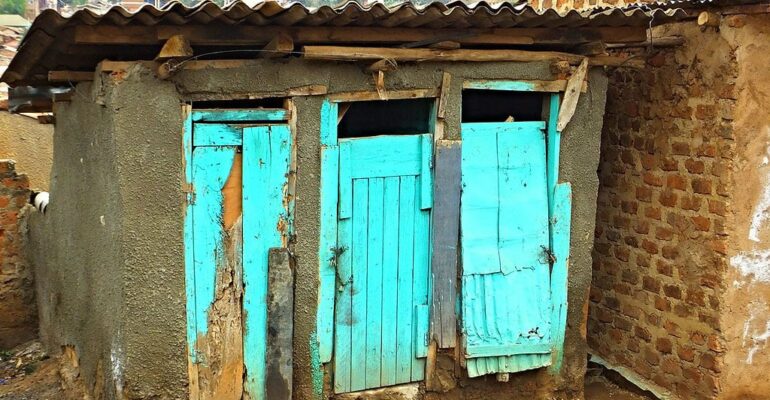Several studies across the country, especially in the capital Kampala, have returned results showing that water sources such as springs, which provide a major source of water for the population are contaminated due to poor waste management and badly-designed pit latrines.
Uganda is currently battling an Ebola outbreak and sanitation is key in the Ebola response. Several studies across the country, especially in the capital Kampala, have returned results showing that water sources such as springs, which provide a major source of water for the population are contaminated due to poor waste management and badly-designed pit latrines.
The poor state of sanitation in Kampala slum areas is reported to contribute to the contamination of 85 % of the protected spring water sources. A toilet or safe drinking water is a stark choice facing many urban poor, including some who get neither.
Kampala is estimated to have more than 4.5 million people traversing through the city daily, yet it has about 1,000 public toilets, which predisposes the burgeoning population to health risks. Open defecation, which leaves many parts of the city littered over lack of latrines among some city residents is common.
The city also has a sewer network of less than 10 %, which is mainly confined in the central business district, according to Kampala Capital City Authority (KCCA). This has led to the ecosystem being exposed to the random discharge of untreated sewage.
“Unimproved sanitation is a major cause of surface and groundwater pollution, which leads to the proliferation of sanitation-related diseases,” KCCA’s directorate of public health and environment notes.
More than 90 % of families utilise pit latrines, the majority of which are unlined, without slabs, bucket latrines and pit latrines and septic tanks discharging into drains.
About 1.8 % of people are thought to be complete without access to a toilet. Due to inadequate infrastructure, operation, and maintenance, about 45 % of pit latrines are abandoned after five years when they are either full or broken down.
The urban poor in informal settlements has little knowledge of or access to pit emptying services since they are unregulated, insufficient, and expensive. In low-income urban settings where the usage of on-site sanitation facilities is high, shallow groundwater is particularly susceptible to faecal pollution.
Faecal sludge, a mixture of human excreta, water and solid wastes including anal cleansing materials, menstrual hygiene management, diapers, plastics, paper and other solid waste are disposed in the pits, tanks or vaults of on-site toilets and sanitation systems, instead of going into centralised wastewater treatment systems.
The methods used in the building of pit latrines and water sources are crucial in assessing the quality of shallow groundwater in urban settings. Therefore, more effort must be put into enhancing the viability and sustainability of on-site water sources and pit latrines.
On November 19, Uganda joined the rest of the world to mark World Toilet Day 2022 under the theme, ‘Making the invisible visible’ which focuses on the impact of the sanitation crisis on groundwater, exploring how inadequate sanitation systems spread human waste into rivers, lakes and soil, polluting underground water resources.
Groundwater is the world’s most abundant source of freshwater. It supports drinking water supplies, sanitation systems, farming, industry and ecosystems. As climate change worsens and populations grow, groundwater is vital for human survival. The central message of World Toilet Day 2022 is that safely managed sanitation protects groundwater from human waste pollution.
Uganda’s urban population is expected to nearly double between 2018 and 2050 putting significant strain on the country’s sanitation infrastructure. Space constraints and the high cost of construction prevent households and institutions from building new toilets when their pit toilets fill up.
In Kampala, slums are characterised by high housing density, lack of land tenure, poor drainage, few toilets which often pollute water sources not forgetting that the cost of constructing a proper pit latrine in a slum is high. Faecal waste management is a major challenge in Katwe II because there are more residents compared to the number of toilet facilities available.
The prevalent use of pit latrines and poor solid waste management practices by slum dwellers have had a significant negative impact on the wetland ecosystem. The construction of toilets is, therefore, not only important for the protection and dignity they provide for inhabitants, they are also key to protecting the environment.
The consequence is premature deaths of under-fives, loss of productivity among the sick populations, and out-of-pocket expenditure for health care services, including treatment. The situation is worse in rural areas which are characterised by strong cultural beliefs and other sanitation-related practices that prevent people from treating drinking water and keeping water sources from contamination.
Access to toilets and sanitation services are also key to gender equality as women are disproportionally affected by a lack of basic sanitation, affecting their personal hygiene, dignity, and safety.
In schools, a lack of proper sanitation facilities also leads to high absenteeism. In addition to students missing school for five to seven days to recover from diarrhoea, the student’s family may have to spend money on medical care or medication to help treat this disease. The impact on parents and their children’s lives is compounded because it is likely that children may contract the disease multiple times per year because in Uganda, two-thirds of households do not wash with soap.
The lack of proper sanitation and hand wash facilities in schools puts students, school administrators and staff at increased risk of bacteria and viral infections such as diarrhoea and Covid-19.
An essential component in the struggle to eradicate neglected tropical diseases (NTDs) is properly managed sanitation. In places where there is a lack of basic sanitation, many diseases thrive. Through contaminated food, water, unclean hands, and direct skin contact with the soil, faecal pathogens such as intestinal worm eggs can contaminate the environment and infect people.
Proper sanitation prevents this from happening. Improved sanitation and water management can make a significant contribution to the reduction of mosquito populations that spread diseases such as lymphatic filariasis, dengue fever, and chikungunya to humans.
Poorly built latrines make it easier for the Culex mosquito, which spreads filarial parasites to people, to reproduce. By maintaining better hygiene, surface water can be protected from contamination by feces and urine that contain worm eggs. This can lessen bilharzia transmission.
For the management of wounds and surgical procedures necessary for the treatment of many NTDs, healthcare facilities and homes also require clean water and hygienic environments.
Only 32 per cent of the population in Uganda has access to a basic water supply and 19 per cent to basic sanitation, with about seven million people still defecating in the open.
“There is no policy framework for financing water, sanitation, hygiene, environment and climate change programmes in Uganda yet they contribute substantially to the national socio-economic development, they are often taken for granted,” Alfred Okidi, permanent secretary, Ministry of Water and Environment, writes.
Although the Government of Uganda (GoU) has stated its goals for bettering cleanliness throughout the nation, access to funds continues to be a major issue. Public investment in sanitation is inadequate when compared to other services, such as drinking water, and no focused financial plan has yet been developed to achieve universal basic service provision.
Overview of sanitation in Kampala
● One percent practicing open defecation.
● Six percent connected to public sewer line.
● 94 percent relies on on-site sanitation facilities
● Less than 70 percent do not have access to improved sanitation
● 50 percent of latrines in informal settlements abandoned; 30 percent are emptied into the environment.
● 64 percent of latrines are unlined

